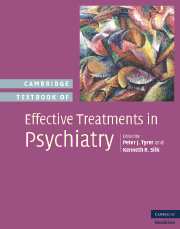Book contents
- Frontmatter
- Contents
- List of contributors
- Preface
- Part I Introduction
- Part II Summary of treatment modalities in psychiatric disorders
- 3 A critical assessment of methods and processes used to develop psychiatric drug treatments
- 4 Section I – The efficacy and safety of electroconvulsive therapy
- 4 Section II – Focal brain stimulation approaches to psychiatric treatment
- 5 The effectiveness of psychological treatments in psychiatry
- 6 Educational interventions
- 7 Complementary and alternative medicine
- 8 Complex interventions
- Part III Specific treatments
- Appendix I Summary of specific drugs having evidence of effectiveness in mental disorders
- Appendix II Key to effectiveness tables
- Index
- References
5 - The effectiveness of psychological treatments in psychiatry
from Part II - Summary of treatment modalities in psychiatric disorders
Published online by Cambridge University Press: 12 May 2010
- Frontmatter
- Contents
- List of contributors
- Preface
- Part I Introduction
- Part II Summary of treatment modalities in psychiatric disorders
- 3 A critical assessment of methods and processes used to develop psychiatric drug treatments
- 4 Section I – The efficacy and safety of electroconvulsive therapy
- 4 Section II – Focal brain stimulation approaches to psychiatric treatment
- 5 The effectiveness of psychological treatments in psychiatry
- 6 Educational interventions
- 7 Complementary and alternative medicine
- 8 Complex interventions
- Part III Specific treatments
- Appendix I Summary of specific drugs having evidence of effectiveness in mental disorders
- Appendix II Key to effectiveness tables
- Index
- References
Summary
Editor's note
Psychotherapy appears to be effective when compared to naturalistic outcome. While the benefits of psychotherapy may differ across different disorders and different types of psychotherapy may be more effective for certain disorders and less effective for other disorders, repeatedly psychotherapy has shown itself to be more effective than naturalistic outcome. While there are many different types of psychotherapy, they essentially fall into two large classes, the psychodynamic therapies, which includes interpersonal psychotherapy, and the behavioral and cognitive-behavioral therapies. There are also a number of other therapies classified as supportive therapy and experiential therapy. Group and systems, including family, therapy can be subsumed under the above groupings. Currently, there is great attention being paid to both the behavioral (including cognitive-behavioral) and the interpersonal psychotherapies because these seem amenable to study via randomized control methodology. These therapies are also time-limited which facilitates their empirical study because there is a specified time limit or time point at which outcome can be measured. What the essential ingredients are that contribute to a successful therapy remain speculative, but client factors, therapist factors, and the maintenance of a healthy and positive alliance between client and therapist appear to be major influences. Others factors include a well-defined contract, encouraging openness in the patient, and maintaining a focus on current life problems and relationships. There is little evidence to support long-term open-ended therapy no matter what the approach.
- Type
- Chapter
- Information
- Cambridge Textbook of Effective Treatments in Psychiatry , pp. 98 - 115Publisher: Cambridge University PressPrint publication year: 2008
References
- 2
- Cited by

